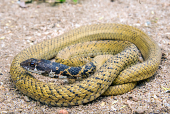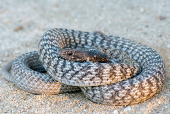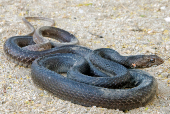Baja California Coachwhip (Masticophis fuliginosus)
Description: Adults are normally 24 to 52 inches long. A slender fast-moving snake with smooth scales, a large head and eyes, a thin neck, and a long thin tail. (There is no well-defined stripe lengthwise on the body in this species.) Large scales above the eyes. 17 rows of scales at midbody. The braided appearance of scales on the tail (like a whip) gives this species its common name. There are two color phases: 1) Dark phase: Dark brown or dark gray to black above. Light edges on dark scales may give the appearance of light lines on the sides, more prominent toward the front of the body. Sometimes appears to be all black. 2) Light phase: Dark or pale yellow, tan, light gray or silvery above with dark zigzag crossbands on the body and wider dark bands on the neck. Only the dark phase has been found in California.
Habitat: A habitat generalist in Baja California, inhabiting scrub, coastal sand dunes, rocky arroyos, thorn forests, marshlands, and sandy flats.
In California, found mainly in open areas such as grassland, shrubland, and coastal sand dunes.
Range: Range extends from southwestern California to southernmost Baja California.
Found in these States:
CA
Diet: Eats small mammals including bats, nestling and adult birds, bird eggs, lizards, snakes, amphibians, and carrion. Hatchlings and juveniles will eat large invertebrates. The ability to tolerate high temperatures enables this snake to hunt heat-dependant lizards when they are active. High speed allows it to run down the fast-moving lizards. Hunts crawling with head the held high above the ground, occasionally moving it from side to side to aid in binocular vision and depth perception.
Reproduction: Mating has been observed in northern Baja California in late April. Females are oviparous, laying eggs. Eggs have been observed in early August.
Status: List as Critically Imperiled in California.
»» Kingdom: Animalia - Animals
»» Phylum: Chordata - Chordates
»» Subphylum: Vertebrata - Vertebrates
»» Class: Reptilia - Reptiles
»» Order: Squamata - Scaled Reptiles
»» Suborder: Serpentes
»» Superfamily: Colubroidea
»» Family: Colubridae - Colubrids
»» Genus: MasticophisS
»» Species: Masticophis fuliginosus - Baja California Coachwhip
This article uses material from the Wikipedia article "Masticophis fuliginosus", which is released under the Creative Commons Attribution-Share-Alike License 3.0. Content may have been omitted from the original, but no content has been changed or extended.
|













